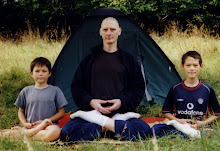OYOSO TOSHO O HANAREZU

"In general, it does not leave this place."
TOSHO means this place, or this moment in time.
This place, or this moment in time, is the instant that a stimulus to activity is reaching our consciousness. In working on the self, it is the only instant that has any value whatsoever.
This teaching was a particular strong point of Gudo Nishijima, who, like many Japanese people I met in Japan, manifested an enviable and seemingly inherent ability to live in the moment of the present. I was aware of this, for example, when a telephone call would interrupt our work in his office. Full attention would be given to the telephone call, after which our work would be resumed, often in mid-sentence, as if the telephone call had never existed.
Marjory Barlow in contrast described herself, as she described me, as "an inveterate worrier." Living in the moment, i.e. not endgaining, was something that she had spent a lifetime consciously working at, indirectly. Her aim was always to bring her pupil in time with the moment of the present, although she never verbalized that aim to me. (She verbalized it in her book, to Trevor Allan Davies.) What she verbalized to me was mainly these directions: "Let the neck be free, to let the head go forward and up, to let the back lengthen and widen; sending the knees away from the hips, pulling to the elbows and widening across the upper part of the arms, as you widen the back." She verbalized those directions and clearly impressed on me that I was not to react to those words in my habitual way, by feeling/doing something partial and specific.
The indirect effect of being led into the space between listening to those verbal directions, and not doing them, was an opening of the innermost ear to the singing of birds, and to the silence in between sounds of traffic in the distance.
In her talk which is reproduced in full on my webpage, Marjory traces FM Alexander's investigative process, from his initial premise that he must be losing his voice because of something he was doing to himself, through backward step after backward step, until he reached the innermost point where he found his wrong doing could be stopped.
"Alexander could not change anything by doing. He could not trust his feeling. He then saw that he had underestimated the strength of habit. What he observed in the mirror was the end-result of disordered patterns lying deep in the nervous system. And that these inner patterns of impulses, conveyed through the nervous system to the muscles acting on the bony structure and joints of the body, were operative perpetually, whether he was moving, speaking or sitting still. In fact these inner patterns were him -- insofar as his body was the outer manifestation of them. The next step in the journey was taken when Alexander realised that the only place where he could begin to control the wrong habitual patterns was at the moment when the idea came to him to speak or move. The moment when, whatever state of misuse he was in, would be made worse as he went into action. He had reached the only place, and the only moment in time, where change could begin, or where he could have any control over the habitual patterns of misuse, which were dominating everything he attempted to do. This place, or this moment in time, was the instant that a stimulus to activity reached his consciousness. In the ordinary way, when a stimulus comes, we react to it in the only manner possible. The response is made without thought -- without any knowledge on our part of what we are putting into motion. The reaction is the immediate response of the whole self, according to habitual patterns of movement which we have developed from our earliest years. We have no choice in this, we can behave in no other way. We are bound in slavery to these unrecognised patterns just as surely as if we were automatons. When Alexander reached understanding of this part of the problem he had found the key to all change. He understood at last in what way he must work. We have now followed him in his journey from the outermost manifestation of misuse, that is the interference with the normal working of his whole body, resulting in the vocal failure, to the innermost point where he could stop this interference."
Sitting-zen is the truth itself. Marjory's teaching was the truth itself.
The truth of sitting-zen and the truth of Marjory's teaching are not two truths. If a person says that it is wrong to identify Marjory's teaching with the truth of sitting-zen, it may not only be that the person has not appreciated the truth of Marjory's teaching; it may also be that the person's sitting-zen has not yet got to the bottom of the truth of sitting-zen.
For anybuddha whose sitting-zen has already got to the bottom of the truth of sitting-zen, there is no need at all to read Marjory's words -- although it might be natural for such a person to be interested in Marjory's words.
For anybody whose sitting-zen has not yet got to the bottom of the truth of sitting-zen, as manifested in unwholesome teachings like pulling in the chin, there may be something still to investigate in Marjory's words.


0 Comments:
Post a Comment
<< Home